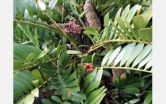(Press-News.org) Tel Aviv ― Environmentalists around the world agree ― plastic bags are choking our landfills and polluting our seas. Now a Tel Aviv University researcher is developing new laboratory methods using corn starch and sugar to help sustainable plastics –– those that biodegrade and are even tougher than those made from petrochemicals –– compete in the industry.
The answer to the problem, Prof. Moshe Kol of Tel Aviv University's School of Chemistry says, is a new variety of catalysts ― substances that initiate or sustain chemical reactions in other substances. His team has already developed several of these new catalysts, and it's currently expanding its activities in partnership with the University of Aachen in Germany and the University of Bath in England.
Prof. Kol is improving the process of making these "green" plastics stronger and more heat-resistant, allowing them to be used in a variety of ways, from the automotive industry to Starbucks coffee cups. The type of plastic the partners are working on, polylactic acid or PLA, is a kind of biodegradable plastic made from renewable plant sources such as corn, wheat or sugarcane. It's already used in bottles, bags, and film, and like polyester can even be woven into clothes.
Making stronger and biodegradable "Lego blocks"
The new catalysts enable the polymerization of lactide, which is the building block of a corn-based plastic. Conventional catalysts have limited control of the way in which these building blocks ― the corn-based molecules ― are assembled ― and they may be toxic. But Prof. Kol's catalysts can be used more safely and efficiently, making "green" plastics more commercially feasible.
"The structure of these corn-based plastics depends on several parameters. The most important is the character of the building blocks, like Lego blocks, that hold the material together," says Prof. Kol. He aims to make sustainable corn-based plastics complement or replace the petroleum-based plastics which can take a millenium to degrade, leaving harmful pollutants in the soil and in water. Corn-based plastic wouldn't cause any adverse health effects and would be expected to biodegrade in a compost bin in a matter of months.
Lord of the plastic ring
Plastics won't be going away any time soon, Prof. Kol suggests, pointing to the movement from concrete or stainless steel to plastic in a variety of industries. Replacing the steel manifold of a car with a plastic substitute would cut down on fuel consumption, and replacing a water pipe made of concrete or metal with one made of corrosion- and crack-resistant plastic may improve the quality of our drinking water.
For disposable items, a perfect plastic material would be a polymer made from renewable resources, that degrades to its original non-toxic form. Plastics made from corn sugar are the most desirable in the industry at the moment.
The preliminary results of Prof. Kol's efforts are in, and the plastics that he and his team produce in the lab look and feel like polystyrene, which could be used for making drinking cups, for example. Rigid and transparent, the drinking cups currently only work for liquids under 122 degrees Fahrenheit, but they represent a first big step into greening plastics and the chemical industry.
INFORMATION:
American Friends of Tel Aviv University (www.aftau.org) supports Israel's leading, most comprehensive and most sought-after center of higher learning. Independently ranked 94th among the world's top universities for the impact of its research, TAU's innovations and discoveries are cited more often by the global scientific community than all but 10 other universities.
Internationally recognized for the scope and groundbreaking nature of its research and scholarship, Tel Aviv University consistently produces work with profound implications for the future.
The sweetness of biodegradable plastics
Tel Aviv University uses sugar and cornstarch to make environmentally safer plastics
2010-12-15
ELSE PRESS RELEASES FROM THIS DATE:
Fighter pilots' brains are 'more sensitive'
2010-12-15
Cognitive tests and MRI scans have shown significant differences in the brains of fighter pilots when compared to a control group, according to a new study led by scientists from UCL.
The study, published today in the Journal of Neuroscience, compares the cognitive performance of 11 front-line RAF (Royal Air Force) Tornado fighter pilots to a control group of a similar IQ with no previous experience of piloting aircraft. All the participants completed two 'cognitive control' tasks which were used to investigate rapid decision making. Diffusion tensor imaging (DTI), a ...
Environmental pharmaceutical contamination removed by Octolig
2010-12-15
An article in the current issue of TECHNOLOGY & INNOVATION, Proceedings of the National Academy of Inventors ™ http://www.cognizantcommunication.com/filecabinet/Technology/techinnovation.html reports on the removal of certain dyes and the antibiotic amoxicillin from water samples using Octolig ®, a commercially available material.
"Because of their properties and the magnitude of their production and use, pharmaceuticals can represent a serious disposal problem," said corresponding author* Dean F. Martin, PhD, of the University of South Florida's Institute for Environmental ...
2 people receive kidney transplants in pilot program using CMU software
2010-12-15
PITTSBURGH—A man in St. Louis and a woman in New Hampshire have received the first kidney transplants made possible through a new national program of the Organ Procurement and Transplantation Network (OPTN) that uses a Carnegie Mellon University computer algorithm to match transplant candidates with living donors.
Both recipients — Ken Crowder of St. Louis and Kathy Niedzwiecki of Pelham, N.H. — had loved ones who were willing to donate a kidney but who were medically incompatible with them. So, through a paired donation, Mr. Crowder's fiancée, Rebecca Burkes, donated ...
A protein called cFLIP makes tumor cells in breast cancer resistant to treatments
2010-12-15
Researchers at the Andalusian Institute for Molecular Biology and Regenerative Medicine (CABIMER) and the University of Granada found that cFLIP –an inhibitor of death ligand-induced apoptosis– is not only essential in breast tumor cells resistance to TRAIL treatments (a death ligand with a potent therapeutic potential against cancer), but this protein is also key to the survival of such cancer cells.
Researchers proved that a variation in the expression of this protein may lead to the normal development of breast epithelium. This is an important finding to be considered ...
Hubble spots a celestial bauble
2010-12-15
The delicate shell, photographed by the NASA/ESA Hubble Space Telescope, appears to float serenely in the depths of space, but this apparent calm hides an inner turmoil. The gaseous envelope formed as the expanding blast wave and ejected material from a supernova tore through the nearby interstellar medium. Called SNR B0509-67.5 (or SNR 0509 for short), the bubble is the visible remnant of a powerful stellar explosion in the Large Magellanic Cloud (LMC), a small galaxy about 160 000 light-years from Earth.
Ripples seen in the shell's surface may be caused either by subtle ...
What 'pine' cones reveal about the evolution of flowers
2010-12-15
From southern Africa's pineapple lily to Western Australia's swamp bottlebrush, flowering plants are everywhere. Also called angiosperms, they make up 90 percent of all land-based, plant life.
New research published this week in the Proceedings of the National Academy of Sciences provides new insights into their genetic origin, an evolutionary innovation that quickly gave rise to many diverse flowering plants more than 130 million years ago. Moreover, a flower with genetic programming similar to a water lily may have started it all.
"Water lilies and avocado flowers ...
Unique case study on Alzheimer's disease
2010-12-15
A case study from the Swedish medical university Karolinska Institutet sheds light on the pathological course of Alzheimer's disease. The brain of the first Alzheimer's patient to display amyloids demonstrable with a PET scanner has been studied, both during progression of the disease and after death.
One pathological characteristic of Alzheimer's disease is the accumulation in the brain of beta-amyloid proteins to form amyloid plaques. However, it is not known how early the plaques forms in the brain, whether they are the primary cause of the disease or what pathogenic ...
Violent games not to blame for youth aggression
2010-12-15
How depressed young people are strongly predicts how aggressive and violent they may be or may become. Contrary to popular belief, however, exposure to violence in video games or on television is not related to serious acts of youth aggression or violence among Hispanics in the US, according to new research by Dr. Christopher Ferguson from Texas A&M International University. His findings are published online in Springer's Journal of Youth and Adolescence.
The potential negative effects of violent video games on adolescent antisocial behavior, and youth violence in particular, ...
Drug use and discrimination among Phoenix area Mexican heritage youth
2010-12-15
Washington, DC, December 14, 2010—Perceived ethnic discrimination among Mexican and Mexican American students from Phoenix-area middle schools places them at risk for increased stress when trying to acculturate with mainstream U.S. culture, according to a new study. As the students experienced acculturation stress related to discrimination, they were at a higher risk for alcohol, cigarettes, and marijuana use. The study is in the December issue of Prevention Science, a peer-reviewed journal of the Society for Prevention Research.
"As levels of perceived discrimination ...
Research leads to fewer yellowjackets on Christmas trees
2010-12-15
Hawaiians can now worry less about finding stray yellowjackets living in their Christmas trees shipped from the mainland United States, partly due to research by a U.S. Department of Agriculture (USDA) scientist and his university and state cooperators.
Every year, fir trees from the Pacific Northwest are shipped to Hawaii for use as Christmas trees. Although yellowjackets usually nest in the ground, mated queens who haven't yet built their nests sometimes make fir trees their home during winter. So, when the trees are harvested in November for shipment to Hawaii, the ...
LAST 30 PRESS RELEASES:
Injectable breast ‘implant’ offers alternative to traditional surgeries
Neuroscientists devise formulas to measure multilingualism
New prostate cancer trial seeks to reduce toxicity without sacrificing efficacy
Geometry shapes life
A CRISPR screen reveals many previously unrecognized genes required for brain development and a new neurodevelopmental disorder
Hot flush treatment has anti-breast cancer activity, study finds
Securing AI systems against growing cybersecurity threats
Longest observation of an active solar region
Why nail-biting, procrastination and other self-sabotaging behaviors are rooted in survival instincts
Regional variations in mechanical properties of porcine leptomeninges
Artificial empathy in therapy and healthcare: advancements in interpersonal interaction technologies
Why some brains switch gears more efficiently than others
UVA’s Jundong Li wins ICDM’S 2025 Tao Li Award for data mining, machine learning
UVA’s low-power, high-performance computer power player Mircea Stan earns National Academy of Inventors fellowship
Not playing by the rules: USU researcher explores filamentous algae dynamics in rivers
Do our body clocks influence our risk of dementia?
Anthropologists offer new evidence of bipedalism in long-debated fossil discovery
Safer receipt paper from wood
Dosage-sensitive genes suggest no whole-genome duplications in ancestral angiosperm
First ancient human herpesvirus genomes document their deep history with humans
Why Some Bacteria Survive Antibiotics and How to Stop Them - New study reveals that bacteria can survive antibiotic treatment through two fundamentally different “shutdown modes”
UCLA study links scar healing to dangerous placenta condition
CHANGE-seq-BE finds off-target changes in the genome from base editors
The Journal of Nuclear Medicine Ahead-of-Print Tip Sheet: January 2, 2026
Delayed or absent first dose of measles, mumps, and rubella vaccination
Trends in US preterm birth rates by household income and race and ethnicity
Study identifies potential biomarker linked to progression and brain inflammation in multiple sclerosis
Many mothers in Norway do not show up for postnatal check-ups
Researchers want to find out why quick clay is so unstable
Superradiant spins show teamwork at the quantum scale
[Press-News.org] The sweetness of biodegradable plasticsTel Aviv University uses sugar and cornstarch to make environmentally safer plastics


